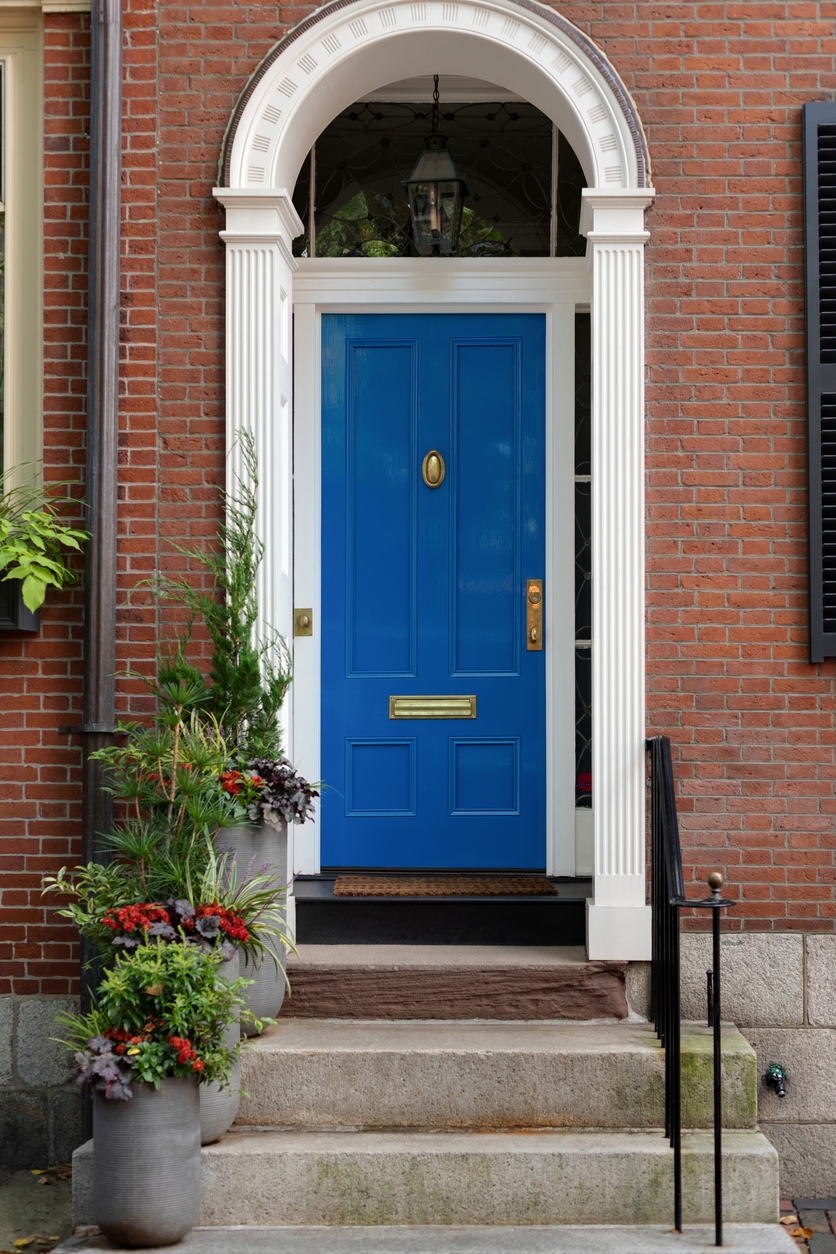Have you ever noticed how a vibrant entryway can completely transform a home’s appearance? The entryway, especially the front door, is the first thing visitors see, and it sets the tone for the entire house. Protect and enhance wood grain for a like-new appearance—book our door refinish & varnish service.
If you paint your entryway in bold colors, you can make a striking statement and create a welcoming atmosphere. There are many ways to achieve this, from using eye-catching colors to including unique design elements. Let’s explore how you can turn your ordinary entryway into something extraordinary with just a few painting techniques.
How to Choose the Right Color Palette
Choosing the right color palette for your entryway is critical to setting the right mood. You can go bold with vibrant, eye-catching colors or keep it subtle with softer shades. Bold colors like deep red or navy can make a big statement and grab attention, while subtler tones like soft blues or greys offer a more relaxed and inviting vibe.
If you’re looking to create a striking effect, consider using complementary colors. These are colors opposite each other on the color wheel. They naturally contrast and balance each other, making the space feel dynamic and visually appealing.
When deciding on the color palette for your entryway, the choice between bold and subtle colors can set the tone for your home’s first impression.
Bold Colors:
- Deep red: A classic choice that exudes energy and passion.
- Navy blue: Conveys a sense of sophistication and authority.
- Vibrant yellow: Adds a cheerful and welcoming vibe.
Subtle Colors:
- Soft blue: Creates a calm and serene atmosphere.
- Warm beige: Offers a cozy and neutral backdrop.
- Light grey: Provides a modern and sleek look.
Techniques for Painting Entryways
Don’t just pick the right colors to make a bold and beautiful entryway. You can also make a great impact with your application techniques. Here are some fun ways to help you highlight features and add texture to your entryway.
Use accent colors
One way to make your entryway stand out is by using accent colors to highlight architectural details. For example, if you have a beautiful door frame or molding, you can paint these features in a contrasting color to make them pop. This technique draws attention to the unique aspects of your home’s architecture and adds a touch of elegance. Imagine a crisp white door frame against a deep blue wall—it’s a simple yet striking way to make an impression.
Here are some more practical examples:
- Paint door frames in a contrasting color to make them a focal point.
- Use an accent color to outline and highlight the molding when painting it.
- Use a contrasting shade for windowsills to make windows look more prominent.
Perform layering and texturing
Adding texture to your entryway can give it a more dynamic and sophisticated look. One popular technique is color blocking, where you use large blocks of color to create a bold pattern or design. This can be done by painting different sections of a wall in contrasting colors. For instance, you could have a vibrant color block at the lower half of the wall and a lighter shade above it.
Another technique is to use textured finishes, like sponging or rag-rolling, to add depth and interest to your walls. These methods can create a soft, textured appearance that adds a touch of artistry to your space.
Practical Painting Tips
Getting a perfect finish on your entryway starts with good preparation and using the right tools. Here are some practical tips to help you get started.
Prep the surface properly
Before you start painting, it’s essential to prepare the surface properly. Begin by cleaning the area to remove any dirt, dust, or grease. Use a mild detergent and water to wash the walls, then let them dry completely. Once clean, inspect the walls for any cracks or holes and fill them with spackling paste. After patching, sand the surface smoothly to ensure the paint adheres evenly. Finally, a coat of primer is applied to help the paint stick better and last longer. Priming also helps to cover any previous colors and provides a uniform base for your new paint.
Have the right tools and materials
Having the right tools can make a huge difference in achieving a professional look. Here’s a list of essentials you’ll need:
- Paintbrushes and rollers: Choose different sizes for precise cutting in and covering larger areas.
- Painter’s tape: It makes clean lines and protects areas you don’t want to paint.
- Drop cloths: This protects floors and furniture from paint splatters.
- Paint trays and liners: It provides easy access to paint and easy cleanup.
- Extension poles: These help you reach high areas without a ladder.
- Sandpaper: Sandpaper is used to smooth surfaces before painting.
- Primer and paint: Choose high-quality primer and paint to get the best results.
How to Avoid Common Mistakes
Avoiding common pitfalls can help you achieve the best results when painting your entryway. Here are some key points to keep in mind:
Harmonize the color with your home design
Choosing the right color is crucial, but it can be tricky. A common mistake is picking a color that clashes with the rest of your home’s design. To avoid this, consider the existing color scheme of your exterior and interior. Look at the shades on your walls, the roof, and even the landscaping. It’s essential to pick a color that complements these elements rather than competes with them.
For example, if your home has a lot of earthy tones, a bold but harmonious color like a rich terracotta or a deep forest green can enhance the overall look.
Choose the right finishes
The entryway is a high-traffic area, exposed to weather and constant use, so choosing durable finishes is key. Opt for paint with a high-quality finish that can withstand these conditions.
Consider using semi-gloss or high-gloss paint for exterior doors and trim. These finishes are more moisture-resistant and easier to clean, making them perfect for withstanding rain, sun, and frequent touching. A satin or eggshell finish is a good choice for interior areas; they offer a durable and easy-to-maintain soft sheen.
Proper ventilation
Always paint in a well-ventilated area to avoid inhaling fumes. This is especially important if you’re using strong-smelling oil-based paints or primers.
Avoid rushing
Give each coat of paint enough time to dry completely before applying the next. This prevents streaks and uneven patches.
Prep for mess
Keep a damp cloth handy to quickly wipe up any spills or drips, and protect surrounding areas with painter’s tape and drop cloths.
Add final touches
Adding the right final touches once the painting is done can elevate your entryway’s look even further. Coordinating elements like door handles, knockers, and house numbers with your new paint color can create a cohesive and stylish appearance. For instance, a sleek black handle on a bold red door can make a striking statement. Don’t forget about lighting—installing a stylish outdoor light fixture can enhance the aesthetic and improve visibility and safety.
Here are some ideas:
- Door handles and knockers: Choose finishes like brushed nickel, brass, or matte black to complement your color scheme.
- Lighting: Consider lantern-style lights for a classic look or modern fixtures for a contemporary vibe.
- Decor: Add a welcoming doormat, seasonal wreaths, or potted plants to make the entryway inviting.
Conclusion
We’ve covered a lot of ground on how to create a bold and beautiful entryway through painting. From choosing the right color palette to highlighting architectural features, using the right techniques and tools, and adding final touches with hardware and accessories, every detail makes your entryway stand out.
Don’t be afraid to experiment with bold colors and creative ideas. A striking entryway is a fantastic way to express your personality and make a memorable first impression.
If you’re feeling inspired but need a little help bringing your vision to life, don’t hesitate to reach out to Custom Painting, Inc. Our team of professionals can assist you in creating the perfect entryway that reflects your style and personality. Contact us today at 925-294-8062 to get started! Serving the Bay area including the cities of Pleasanton, San Ramon, Santa Clara, Sunnyvale and Sunol.



